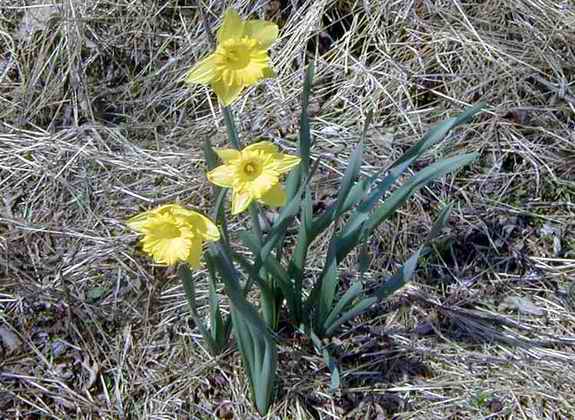|
Common Name: Daffodil, Narcissus, Jonquil, Daffy-down-dilly, Lent Lily. Scientific Name: Narcissus pseudonarcissus
The many names of the daffodil are evidence of its profligate spread and speciation. A native of Europe, predominantly in the Mediterranean region, the daffodil has been hybridized over hundreds of years to produce so many cultivars that they are grouped into twelve divisions with upwards of fifty species. The first division is the trumpet type, pseudonarcissus, native to Britain and France. They are characterized by large yellow coronas (the center part of the flower) and yellow perianths (the outer collar around the corona). It is likely that this was the predominant species planted by early settlers.
The daffodil is a bulbous plant, and accordingly can spread by either seed or by bulb. In the latter case, the bulbs multiply by division, each new plant a clone of the original. With seed dispersal, however, the plants usually produce flowers that are different, thus leading to extensive natural hybridization. The tenth division of daffodils is thus comprised of wild hybrids. It is mostly the daffodils of this division that are found growing throughout the Appalachians to mark the site of former homesteads. The name Lent Lily is commonly applied to these hybrids as they appear during the Lenten season.
Daffodil has an uncertain etymology. It dates from 1592 and is derived from the Medieval Latin affodillus which in turn is from the Latin asphodillus which is a direct descendent of the Greek asphodelus, which is of unknown origin, but is the name given to the asphodel, a flower of the lily family that grows in the eastern Mediterranean. It is surmised that the initial "d" is from the French article and that the original form may have started as d'asphodel, as both flowers are of the lily family and the bulbs were obtained in the Netherlands. The name Jonquil is from one of the species names of the flower, N. jonquilla which derives from the Latin juncus meaning rush or reed in reference to the leaves. The jonquil species is characterized by clusters of small yellow blossoms.
Narcissus is of much more certain origin. It is a derived from the Greek word narke which means numbness and stems from the verb narkoun, to stupefy. Narcotic is also derived from this root word. According to sources as venerable as the Greek historian Plutarch (CE 46-120), the association of narke with narcissus is due to the narcotic effects produced by the plant, whose bulbs contain a toxic, paralyzing alkaloid. Its first known use as a name for the genus was in William Turner's book on herbs in 1548.
In Greek Mythology, Narcissus was a Thespian youth of such pulchritudinous appearance that he became arrogant, spurning suitors of both sexes. Among those attracted was Echo, a woodland nymph or Oread. Echo had been punished by Hera for distracting her with chattering and singing when Zeus was paying court to another female. For this, Echo was condemned to be bereft of speech except to repeat only the last syllable of words spoken to her. When Narcissus rejected her, she died of a broken heart, her bones turned into stone, and all that was left was the echo of her voice. Nemesis, the goddess of vengeance, was sought out by the other gods to seek retribution for the tragic death of Echo. Shortly thereafter, Narcissus was leaning over the limpid waters of a pond when he saw a beautiful face looking back at him. He so fell in love with his own reflection that he could not depart, slowly wasting away until he expired on that spot. When the nymphs came to bury him, they found only a flower with a yellow center surrounded by petals. According to Book III of Ovid's Metamorphoses, Narcissus even found a pool in Hades to stare at, "watching his image in the Stygian waters."
Daffodil bulbs contain a constituent that is toxic if consumed in large quantities. It acts as an emetic that causes eventual collapse and death by paralysis of the central nervous system. However, like most toxins, moderate dosages can have salubrious results. The narcotic nature of the narcissus has long been a matter of practical medical knowledge, as even Galen (Greek Physician Claudius Galenus 130-200 CE) noted its astringent properties. In the late 19th Century, the chemical composition of the plant was analyzed by a number of researchers. It was determined that the bulbs contained a crystalline alkaloid (C16H17ON) that was given the name narcissine. In 1920, it was found that the chemical was identical to that of lycorine, by which name it is currently known.
Decoctions made from the Narcissus have long been used for medicinal purposes. Its primary use was as an emetic, as experimentation with cats had shown that an eighth of a gram resulted in "vomiting, salivation and purgation." A tonic made from narcissus extract mixed with honey, frankincense, wine and myrrh was applied in the ears against "corrupt and running matter." The oil of the narcissus was the basis for an ancient ointment called Narcissimum, which is still available as a commercial product. More recently, daffodil bulbs are being used to produce the chemical galantamine, which is one of the drugs used in the treatment of Alzheimer's disease. |
